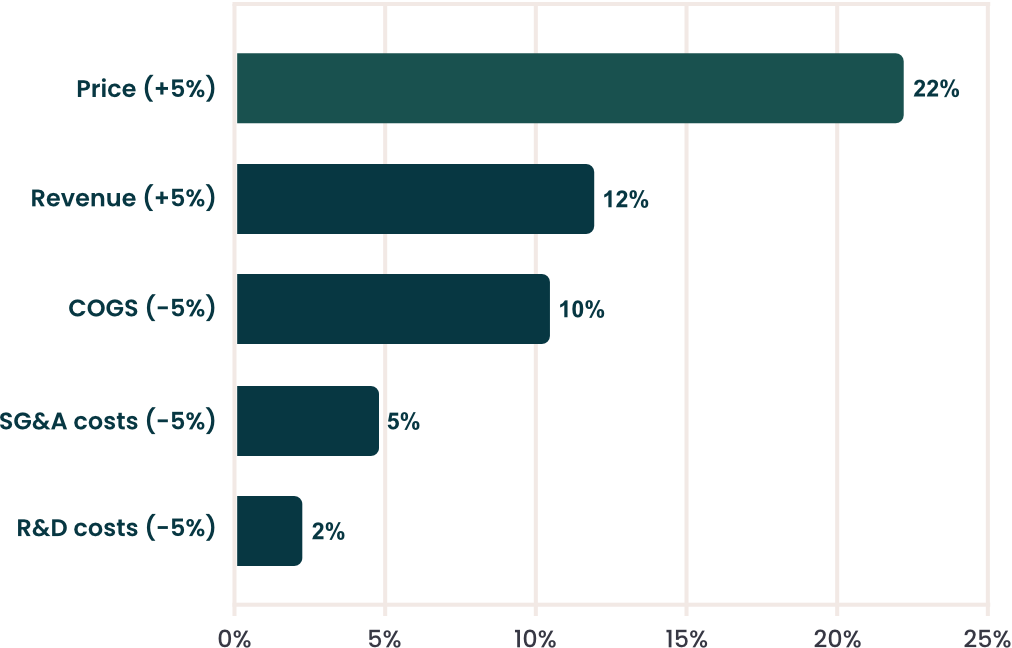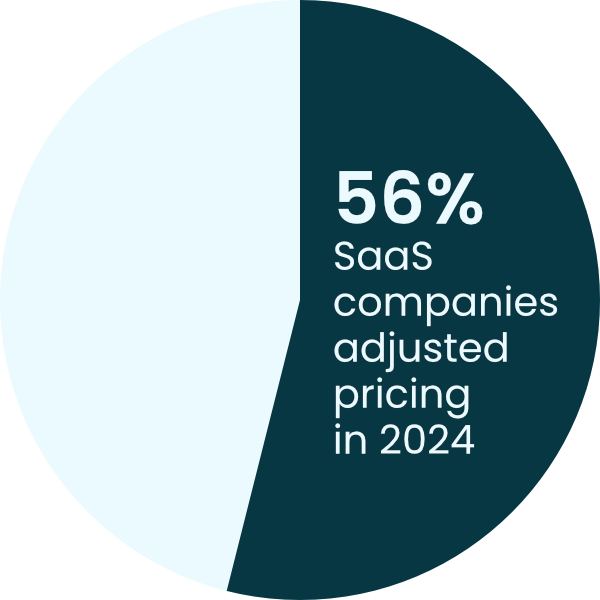How to Raise SaaS Prices Without Losing Your Best Customers
Price increases aren't a risk—they're a growth strategy
SaaS products evolve constantly. You're not selling a static tool—you're selling access to something that gets better every month.
More features. More integrations. Better UX. More value.
But while your product compounds in value, your pricing often stays stuck in the past. That gap is a missed opportunity—and a drag on efficiency, expansion, and long-term margins.
Done right, a price increase isn't just a necessary evil—it's one of the highest-leverage growth moves a SaaS company can make.
Why Price Increases Work (and Matter More Than You Think)
For most SaaS companies, price increases beat almost any other growth lever. A study of Fortune 500 companies found that a 5% price increase can drive a 22% increase in operating profit—more than increasing sales volume or reducing costs.

Impact on EBIT of 5% price increase vs other methods
When your CAC is high and marginal cost is low (as it is in SaaS), monetizing existing customers more effectively is where efficiency lives. You already spend to acquire and serve your customers. A higher ARPU compounds all the way down the funnel.
How Often Should You Increase SaaS Prices?
More than half of SaaS companies now raise prices annually. That trend is accelerating. In 2024, 42% of SaaS companies adjusted their prices just in the first three quarters (source: PricingSaaS Index). That implies over half of SaaS companies now raise prices at least once per year.

You should also revisit your pricing at least once per year to assess whether you've added meaningful value. If you go more than two years without reviewing pricing, you're likely underpricing.
The key isn't to follow a fixed calendar, but to align your pricing changes with product improvements, customer segmentation, and strategic goals.
If your product has become meaningfully more valuable, your pricing should reflect that. Just make sure each customer sees pricing changes no more than once a year.
Grandfathering: Helpful, but Overused
What is it?
Grandfathering gives existing customers a grace period where they keep their current pricing—while new customers pay the updated rate.
It's often seen as a courtesy. In practice, it's a tradeoff.
When to use it
- Reduce churn during a price change
- Avoid overwhelming support and success teams
- Give customers a feeling of trust and continuity
But it comes at a cost. Many companies grandfather for too long, adding complexity with minimal upside.
Here's the truth: long grandfathering periods are a tax on your growth.
Too many pricing versions, multiple billing experiences, and missed revenue from your most loyal customers. It slows down product development and makes negotiations harder.
A better approach
- Set a clear expiration: 6-12 months max is usually enough
- Communicate proactively: Let customers know what's changing and when
- Don't avoid short-term churn at the cost of long-term margin
How Much Should You Raise Prices?
There's no universal answer—but here's how to think about it:
- If you haven't raised prices in 12-24+ months, and the product has improved, it's time.
- If your close rates are too high or deals feel too easy, prices are likely too low.
- If you're not hearing any price-related feedback, it's a sign you have room to raise.
How to Run SaaS Pricing Experiments (Safely)
Pricing experiments let you find the right price before rolling it out across your base.
Here's how to run one:
- Split new customers into a control group (old pricing) and a test group (new pricing)
- Measure conversion rates, CAC payback, churn, and expansion
- Iterate—try higher (or lower) variants until you see a meaningful tradeoff
- Roll out the new price when you're confident in the data
Pricing experiments are a core part of how high-performing SaaS companies scale using pricing.
We've written a full handbook on pricing experimentation, and at Potio, we help SaaS companies run these experiments.
It's Okay to Lose Some Customers
Some churn after a price increase is expected—and healthy.
In fact, if you raise prices and don't lose anyone, you probably left money on the table.
The key is understanding who churns. Losing your most price-sensitive customers is okay—especially if you retain your most engaged, highest-value users.
Those who stay often:
- Are less support-intensive
- Expand more over time
- Advocate for your brand
- Are more aligned with your roadmap
Price increases can actually improve your customer base by filtering out those with low LTV and high maintenance costs.
If you're nervous, remember this: Churn is visible. Underpricing isn't.
How to Communicate a Price Increase
Communicating the change well is as important as the change itself.
Best practices:
- Be clear and specific. Show current price, new price, and the effective date.
- Segment your message. Only notify users who are affected. Avoid irrelevant noise.
- Give reasonable notice. 60-90 days is usually best. Enough time to prepare, not enough to forget.
- Make it personal. Don't ask users to “go find” what changes—tell them directly what applies to them.
- Anchor to value. Remind them of what's improved since their last price update.
- Avoid excuses. Don't blame inflation or external trends. Own the decision.
- For enterprise customers. Go beyond email. Book calls or in-person meetings. Be prepared to explain, negotiate, and reinforce value.
Sample Price Increase Email
Subject: Important Update: Your Pricing Is Changing
Hi [First Name],
We're reaching out to let you know that the price of your [Plan Name] plan will change starting on [Effective Date].
- Your current price: $XX/month
- Your new price: $YY/month
- When this takes effect: [Date]
Since you joined, we've shipped over [#] major improvements—including [list 1–2 key features or enhancements]. These changes reflect the continued investment we're making in helping you [achieve X outcome].
You don't need to take any action—this change will be reflected in your next billing cycle after [date]. If you're on an annual plan, this change won't apply until your next renewal.
Want to lock in your current price for longer? You can upgrade to an annual plan here.
Thanks for being part of [Company Name]. We're committed to continuing to deliver more value every month.
— The [Company] Team
Price Increases Can Boost Retention, Too
You can use pricing changes as a retention play, not just a revenue one.
- Promote annual plans to monthly users—especially if your new annual rate is close to their current monthly price.
- Offer multi-year agreements at current pricing in exchange for upfront commitment.
Locking in loyal customers helps you trade some short-term ARPU for longer-term stability.
Expect Pushback. Don't Panic.
The reality of most price increases is that some customers will complain. Some might churn. Others will try to negotiate.
That doesn't mean you made a mistake—it means your pricing matters. It's important to stay grounded in your original, well-considered decision and to track key metrics closely. In fact, if you receive no negative feedback, that's a sign you likely didn't raise prices enough.
What matters is how you respond—and that you stay the course:
- Stick to your timeline
- Monitor key metrics
- Train your support and success teams
- Stay focused on the data that led to your decision
Don't let loud feedback override confident execution.
Handling Large, Sales-Led Accounts
For larger contracts, make sure your pricing model gives you flexibility to adjust over time.
Key tactics:
- Keep pricing out of the MSA
- Structuring renewals so continued usage = acceptance of pricing updates
Don't lock yourself into multi-year fixed pricing without a clause for adjustment—don't give up pricing power.
Final Take
Most SaaS companies wait too long to raise prices. Or they do it reactively. Or they overthink it and grandfather for years.
Avoiding them feels safe, but costs you more over time. The longer you wait, the harder it gets.
Improve. Learn. Raise. Communicate. Repeat.
And if you're ready to run your next price increase with confidence, Potio helps SaaS teams test, implement, and roll out pricing changes—without losing their best customers.